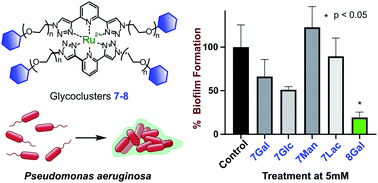Ruthenium-centred btp glycoclusters as inhibitors for Pseudomonas aeruginosa biofilm formation†
Abstract
Carbohydrate-decorated clusters (glycoclusters) centred on a Ru(II) ion were synthesised and tested for their activity against Pseudomonas aeruginosa biofilm formation. These clusters were designed by conjugating a range of carbohydrate motifs (galactose, glucose, mannose and lactose, as well as galactose with a triethylene glycol spacer) to a btp (2,6-bis(1,2,3-triazol-4-yl)pyridine) scaffold. This scaffold, which possesses a C2 symmetry, is an excellent ligand for d-metal ions, and thus the formation of the Ru(II)-centred glycoclusters 7 and 8Gal was achieved from 5 and 6Gal; each possessing four deprotected carbohydrates. Glycocluster 8Gal, which has a flexible spacer between the btp and galactose moieties, showed significant inhibition of P. aeruginosa bacterial biofilm formation. By contrast, glycocluster 7, which lacked the flexible linker, didn't show significant antimicrobial effects and neither does the ligand 6Gal alone. These results are proposed to arise from carbohydrate–lectin interactions with LecA, which are possible for the flexible metal-centred multivalent glycocluster. Metal-centred glycoclusters present a structurally versatile class of antimicrobial agent for P. aeruginosa, of which this is, to the best of our knowledge, the first example.



 Please wait while we load your content...
Please wait while we load your content...